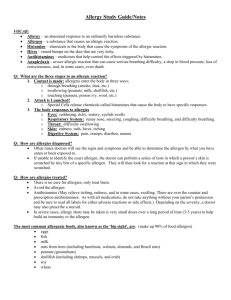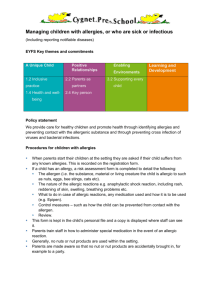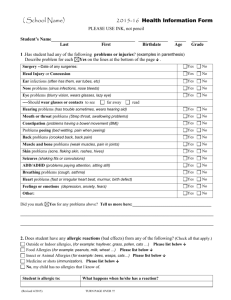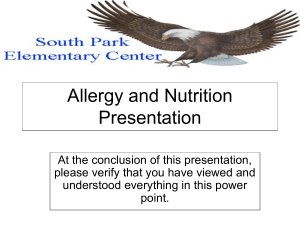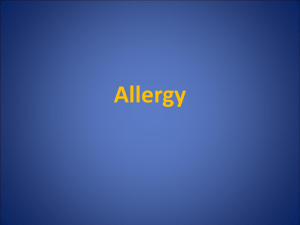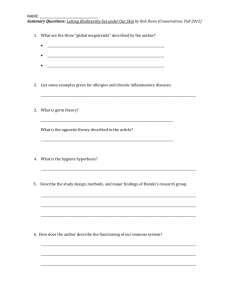Glossary of Allergy Terms
advertisement
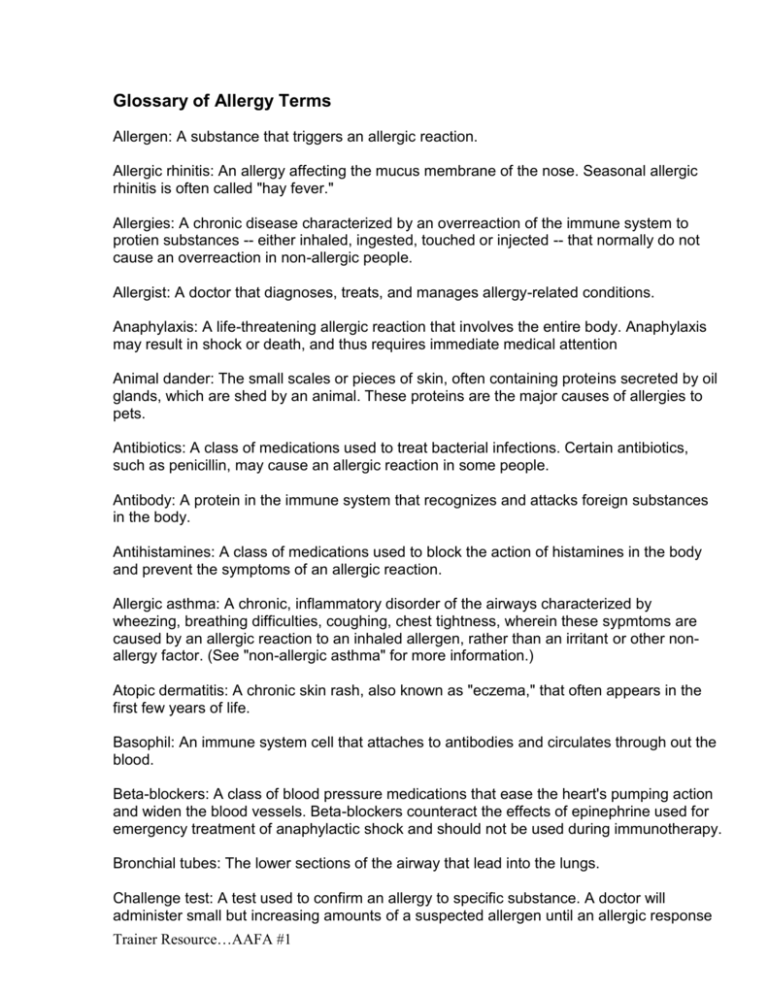
Glossary of Allergy Terms Allergen: A substance that triggers an allergic reaction. Allergic rhinitis: An allergy affecting the mucus membrane of the nose. Seasonal allergic rhinitis is often called "hay fever." Allergies: A chronic disease characterized by an overreaction of the immune system to protien substances -- either inhaled, ingested, touched or injected -- that normally do not cause an overreaction in non-allergic people. Allergist: A doctor that diagnoses, treats, and manages allergy-related conditions. Anaphylaxis: A life-threatening allergic reaction that involves the entire body. Anaphylaxis may result in shock or death, and thus requires immediate medical attention Animal dander: The small scales or pieces of skin, often containing proteins secreted by oil glands, which are shed by an animal. These proteins are the major causes of allergies to pets. Antibiotics: A class of medications used to treat bacterial infections. Certain antibiotics, such as penicillin, may cause an allergic reaction in some people. Antibody: A protein in the immune system that recognizes and attacks foreign substances in the body. Antihistamines: A class of medications used to block the action of histamines in the body and prevent the symptoms of an allergic reaction. Allergic asthma: A chronic, inflammatory disorder of the airways characterized by wheezing, breathing difficulties, coughing, chest tightness, wherein these sypmtoms are caused by an allergic reaction to an inhaled allergen, rather than an irritant or other nonallergy factor. (See "non-allergic asthma" for more information.) Atopic dermatitis: A chronic skin rash, also known as "eczema," that often appears in the first few years of life. Basophil: An immune system cell that attaches to antibodies and circulates through out the blood. Beta-blockers: A class of blood pressure medications that ease the heart's pumping action and widen the blood vessels. Beta-blockers counteract the effects of epinephrine used for emergency treatment of anaphylactic shock and should not be used during immunotherapy. Bronchial tubes: The lower sections of the airway that lead into the lungs. Challenge test: A test used to confirm an allergy to specific substance. A doctor will administer small but increasing amounts of a suspected allergen until an allergic response Trainer Resource…AAFA #1 is noticed. Due to the risk of anaphylaxis, this should only be performed under a controlled setting. Conjunctivitis: Inflammation of the conjunctiva, or the mucous membrane surrounding the eye. Also known as pinkeye. Contact dermatitis: An allergic reaction resulting from skin contact to an allergen. Corticosteroid: An anti-inflammatory medication used to treat the itching and swelling associated with some allergic reactions. Cromolym sodium: An anti-inflammatory nasal spray used to treat and sometimes prevent allergic rhinitis. Decongestants: A class of medications used for nasal congestion. Decongestants are available in oral doses, nasal sprays, or eye drops (for conjunctivitis). Drug allergies: A chronic disease characterized by an overreaction of the immune system in some people to certain types of medications such as penicillin, aspirin, etc. Dust mites: A microscopic organism that lives in dust. Eczema: See Atopic dermatitis. Eosinophil: A specific type of immune cell that can cause tissue damage in the late phase of an allergic reaction. Epinepherine: A medication used for immediate treatment of anaphylaxis by raising blood pressure and heart rate back to normal levels. Epinepherine is also known as adrenaline. EpiPen: A device used to inject epinephrine during an anaphylaxis attack. Eye allergies: A chronic disease characterized by an overreaction of the immune system to protiens get into the eye (also called "allergic conjunctivitis). Food allergies: A chronic disease characterized by an overreaction of the immune system to food protiens. Heparin: A chemical released by basophils and mast cells that causes nearby tissues to become swollen and inflamed. Histamine: A chemical released by basophils and mast cells that causes nearby tissues to become swollen and inflamed. Hives: See urticaria. Immunoglobulin E (IgE): A type of antibody responsible for most allergic reactions. Trainer Resource…AAFA #1 Immunotherapy: A series of shots that help build up the immune system's tolerance to an allergen. Indoor allergies: A chronic disease characterized by an overreaction of the immune system to certain protiens found inside, such as mold spores, pet dander, cockroach or dust mite allergen, etc. (also called "perennial allergies"). Insect allergies: A chronic disease characterized by an overreaction of the immune system to certain insect protiens such as venom from stining or biting insects (bees, wasps, ants, spiders), or even allergens from cockroaches and dust mites. Insulin: A hormone that regulates blood sugar levels. Diabetics who take insulin derived from animals may have allergic reactions. Intradermal test: A test where an allergen is injected just underneath the skin. Intradermal tests are generally used when results from a skin prick test are unclear. Late phase: The period 4 to 24 hours after exposure to an allergen where tissue damage may occur. Latex allergies: A chronic disease characterized by an overreaction of the immune system to latex protiens found in many rubber or latex products. Latex allergies may occurr due to touching latex or even inhaling latex dust. Lymphocyte: A specific type of immune cell that can cause tissue damage in the late phase of an allergic reaction. Mast cell: An immune system cell which attaches to antibodies and is located in the tissue that lines the nose, bronchial tubes, gastrointestinal tract, and the skin. Neocromil sodium: An inhaled medication used to treat inflammation involved with asthma. Neutrophil: A specific type of immune cell that can cause tissue damage in the late phase of an allergic reaction. Otitis media: A middle ear infection. Otitis media with effusion occurs when fluid builds up within the ear. Outdoor allergies: A chronic disease characterized by an overreaction of the immune system to certain protiens found outside, such as tree/grass/weed pollen, mold spores, stinging insects, poisonous plants, etc. (also called "hayfever," "nasal allergies," or "seasonal allergies"). Radioallergosorbant test (RAST): A blood test that measures the amount of IgE antibody produced when the sample is mixed with a specific allergen. Rhinitis: An inflammation of the nasal passageways, particularly with discharge. Trainer Resource…AAFA #1 Sinusitis: An inflammation or infection of one or more sinuses. The sinuses are hollow air spaces located around the nose and eyes. Skin allergies: A chronic disease characterized by an overreaction of the immune system to certain protiens that come incontact with the skin (often appears as a rash, eczema, etc.). Also, "skin" allergies may refer to other types of allergies and have symptoms which appear on the skin causing hives, eczema, psoriasis, etc. Skin prick test: A test where a needle is used to scratch the skin with a small amount of allergen. A response can usually be seen within 15 to 20 minutes. Urticaria: Raised areas of the skin that are often red, warm, and itchy. Urticaria is also known as hives. Urushiol: An oil found on poison ivy, oak, and sumac. © Asthma and Allergy Foundation of America www.aafa.org 1-800-7-ASTHMA Trainer Resource…AAFA #1

